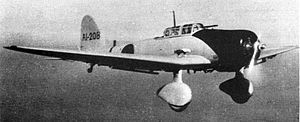From the Archives — Robert Diemert Restored a Japanese Val
By Ian Brown, Editor
July 2020 – I mentioned last month that the Canadian soaring championships were held 1970 in Carman, Manitoba. In reviewing the July 1970 edition, I discovered that Robert Diemert, Friendship Field, Carman, Manitoba (CJB2), also went out of his way (significantly) to find and restore a Japanese Val fighter aircraft, using funds earned flying as a stunt pilot in the film Battle of Britain. He was one of the first warbird restorers and was responsible for writing Japanese Aircraft Restored and Aircraft Restored by Robert Diemert. — Ed.
Japanese Val Restored in Canada (Warbirds division of EAA Sport Aviation, July 1970)
ROBERT DIEMERT, who operates Friendship Field in Carman, Manitoba, owns and flies one of the rarest of all aircraft, an Aichi K-99 Val dive and torpedo bomber used by the Japanese Imperial Navy in World War II. Bob retrieved what was barely recognizable as the remains of one of this type from a South Pacific island, and it represented what was probably the "best of the worst" to be had. Because, at the end of the Pacific War hostilities, all remaining Vals, as well as all other Japanese military types, were ordered destroyed by the Allied High Command.
The Val — the Aichi T-99, designated the K-99 by the Navy — was the first all-metal monoplane dive bomber built by Japan, and saw extensive action at Pearl Harbor and during the first half of the Pacific War. It was an attack by Vals that sent the British carrier Hermes and the cruisers Cornwell and Dorsetshire to the bottom of the Indian Ocean in April 1942. Toward the end of the war, some Vals were converted to single-seat suicide aircraft.

Aichi D3A1 Val example, which flew from carrier Akagi.
With a 48-foot span and 37-foot length, the Val is a huge beast. Its most identifiable feature is its elliptical wing, very similar to that of the Spitfire. The fuselage is monocoque, and a long dorsal fin extends almost to the rear cockpit. The ship carried a crew of two, and its armament consisted of two fixed forward firing guns and one or two movable rear guns. Huge wheel pants dress up the fixed landing gear, and fixed slots are attached to the underside of the wing.
The Val was one of about 20 Japanese aircraft discovered on Bougainville and identified from aerial photographs. In January 1969 Bob flew to Bougainville, which is under Australian trusteeship, and negotiated with the Australian government to acquire the Val along with three Zero fighters. The airplanes were on the long-deserted Ballaie airfield, grown over with tall grass and jungle since the base was evacuated by the Japanese in 1943 and the airplanes abandoned. Not that they could have been flown out even then, as the hulks were bullet-riddled and shrapnel-scarred.
They now were suffering from many years of corrosion. Bob and his crew of native helpers fought off the repeated onslaughts of hordes of insects while dismantling the airplanes. Once dismantled, the components were moved from the airfield to a point where they could be loaded aboard barges and towed to Port Moresby, New Guinea. It was at Port Moresby where Bob really lucked out when a number of Canadian Armed Forces Lockheed Hercules transports stopped over while on a round-the-world training mission. Bob was successful in quickly negotiating transportation of the airplanes to Winnipeg by promising to restore one of the Zeros for permanent exhibition in the Canadian War Museum in Ottawa.
Once the airplanes were in Carman, restoration of the Val was begun. The structure under the aluminum skin turned out to be in acceptable condition, despite the fact that these craft sat in an area for 25 years where annual rainfall is 350 inches. Bob was again fortunate in obtaining copies of the drawings from the original designer who had hidden the plans after the Japanese surrender. Along with three assistants, Bob spent 4,800 man-hours rebuilding the ship. Paint chips from Vals were sent from Japan and matched in Winnipeg.
The original engines just rusted away, and a Wright R-2600 from a B-25 was used to replace the original Aichi radial. The propeller, as well as the cowl off the B-25, was also used. The airplane has since been restored and, following taxi tests, last November found the Val ready for flight testing. The testing came off without a hitch and the ship proved easy enough for Diemert to handle. Almost an hour was logged but, unfortunately, in the excitement of finishing the project, Bob forgot to get the DOT to sign off the airplane and approve the flight. Diemert, who previously restored a Hawker Hurricane II, stated that the Val had more torque than either a P-51 or the Hurricane.
In addition to the Val and the three Zeros, Diemert also owns a P-40 and an ex-RAAF Fairey Firefly. One large Tokyo daily newspaper was planning to sponsor flying shows involving the Val and two Zeros at Expo 70, but the Zeros likely are not finished yet. A Japanese syndicate is said to be planning a strong bid in an attempt to purchase at least two of the four airplanes, so maybe Bob did make a shrewd investment.
Googling Robert Diemert, Carman, Manitoba, and the current proprietor of the airfield, you'll find this fascinating YouTube video of Bob in 1988 (although the video wasn't posted until 2013). The documentary, about his Defender project, portrays a man with an enormously creative, some might say eccentric, mind. Most of us would just accept an off-the-shelf wing design, but a lot of the video focuses on wing design. There is some fascinating footage in the second half of the Confederate Air Force and his reconstruction of a Japanese Zero. — Ed.
